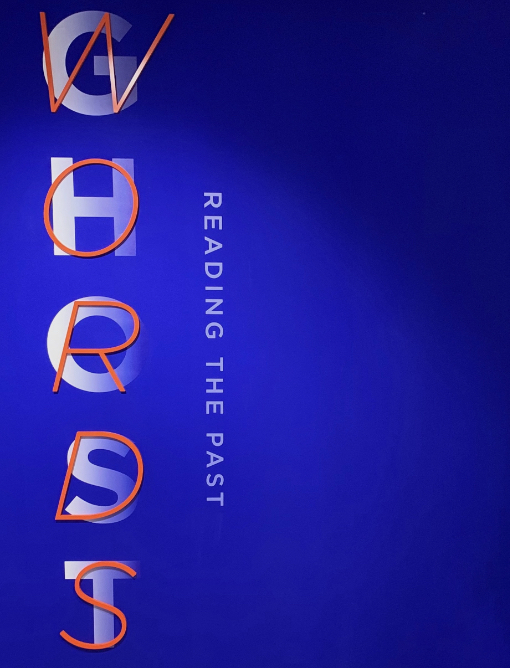Ghost Words: Reading the Past
...by examining it in different lights and using every clear day for about four months, I succeeded in reading and noting every letter..." Samuel Prideaux Tregelles on his edition of the Gospel of Luke from Codex Zacynthius, 1863.
A palimpsest [PA-lim(p)-sest] is a manuscript that has been cleaned and used again, a newer text written over an older one.
Palimpsests are the literary equivalent of buried treasure, and scholars over the last two centuries have patiently sought to decipher the lost or forgotten words hidden under layers of newer ink.
The word palimpsest comes into English via Latin, palimpsēstus. The Latin came from a Greek compound ‘to rub smooth again’; referring to the rubbing clean of parchment. The layered structure of parchment – the skin of calves, goats, sheep or other animals – allowed it to be scraped and used again in a way that is more difficult for paper.
Scribes created palimpsests out of a simple need for more writing material at times when parchment was scarce or too expensive. They did reflect on which texts to efface, however. Common texts might be erased without fear of real loss. Uncommon writings might be deliberately suppressed. Linguistic change led one language to supplant another. Doctrinal or liturgical change caused the abandonment of formerly popular works. Official status bestowed on one form of a text might spell elimination for all others.
The manuscripts in this collection feature in an online exhibition launched in March 2021.

-
al-Qurʼān (MS Add.1125)
Fragments of a Hijazi Qurʼān probably written in the second century A.H. / eighth century A.D., containing verses from the … more -
Arabic hagiographic palimpsest with Greek Old Testament undertext (Cambridge, University Library, MS Add. 1879.5)
This fragment consists of a small scrap of parchment from an Arabic hagiographic palimpsest with Greek Old Testament undertext. … more -
Sticherarion (Cambridge, University Library, MS Add. 1879.15)
This fragment is a single folio of a palimpsest manuscript, whose original text dates to the 10th or 11th century, and the … more -
Archimedes Palimpsest (Cambridge, University Library, MS Add. 1879.23)
This fragment is a single folio of the Archimedes Palimpsest, a manuscript originally copied in the middle or later 10th … more -
Palimpsest; St Augustine; masora (Add.4320d)
Palimpsest of Tiberian masoretic notes on Isaiah over St Augustine, Sermo 225 in Latin. The Latin hand, which records a sermon … more -
Gospel lectionary palimpsest, with Menologion undertext (Cambridge, University Library, MS Add. 4489)
This fragment consists of unbound folios of a Gospel lectionary palimpsest, with Menologion undertext. The original manuscript, … more -
Palimpsest of Homer and John Chrysostom (Cambridge, University Library, MS Add. 7872)
This fragment is a single folio of a palimpsest manuscript containing originally a copy of the Iliad of Homer in majuscule, … more -
Gospel lectionary (Saturdays, Sundays and weekdays) (Cambridge, University Library, MS Add. 10062)
The upper, more recent writing, is a copy of the New Testament written out in the sequence of the Byzantine lectionary. The … more -
Pauline Epistles with catena (Cambridge, University Library, MS Ff.1.30)
This manuscript is the latter part of a book containing the Pauline Epistles with catena, a supporting sequence of extracts … more -
Greek texts on mathematics, astronomy and geography (Cambridge, University Library, MS Gg.2.33)
Manuscript Gg.2.33 is a composite volume comprising various Greek texts on mathematics, astronomy and geography by Ptolemy, … more -
Compilation of classical, late antique and medieval poetic works (including the 'Cambridge Songs') (MS Gg.5.35)
Introduction: the history of the manuscriptCopied by perhaps four scribes during the mid-11th century, this manuscript contains … more -
Talmud; palimpsest (L-G Glass 1a)
Palimpsest. Upper text: Palestinian Talmud Horayot 48a, ca. 10th century. Under text: Christian Palestinian Aramaic, Life … more -
Ephraem Syrus and moral texts (Cambridge, University Library, MS Nn.4.8)
Nn.4.8 is a composite manuscript consisting of two original parts, containing mainly texts of Ephraem Syrus and moral texts. … more -
Christian Arabic homilies of the Church Fathers (MS Or.1287)
The Cambridge manuscript is the largest part of a codex of which a few leaves are scattered among different institutions: … more -
Miscellaneous correspondence (RGO 4/187)
An envelope of 48 items of correspondence which previously belonged to the long-serving Astronomer Royal Nevil Maskelyne, … more -
Palimpsest; piyyut; Bible (T-S 12.182)
Palimpsest. Upper text: piyyuṭim by Yannai, qeduštaʾot for the reading of two sedarim in the Palestinian triennial cycle, … more -
Palimpsest; Bible (T-S 12.183)
Palimpsest of Palestinian Talmud, Bava Qama 9 (4d-5a, 6c-d), over an Old Georgian translation of the Hebrew Bible, Jeremiah … more -
Palimpsest; Bible; piyyuṭ (T-S 12.184)
Palimpsest with Aquila’s Greek translation of I Kings 21:7-17 (3 Kings in the Greek Bible), overwritten with piyyuṭim of … more -
Palimpsest: New Testament; piyyuṭ (T-S 16.98)
A palimpsest, the upper script consisting of a collection of qerovot by Yannai from a 10th-century (?) maḥzor of his work. … more -
Palimpsest; Bible; piyyuṭ (T-S 20.50)
Palimpsest with Aquila’s Greek translation of II Kings 23:11–27 (dating to the 6th century), overwritten with piyyuṭim of … more -
Legal document; piyyuṭ (T-S Ar.41.131)
Recto: petition to the vizier of al-Ẓāfir, Abū Ḥasan ʿAlī Ibn al-Salār regarding a fief worth 5500 dinars and a village of … more -
Palimpsest; St Augustine; masora (T-S AS 139.1)
Palimpsest of Tiberian masoretic notes on 1 Samuel 9 over St Augustine, De Sermone Domine in Latin. The Latin hand can be … more -
Palimpsest; Bible; writing exercises; magical; legal document: ketubba; piyyuṭ (T-S K23.3)
Three unconnected palimpsest fragments. Fragment 1 (P1) is from a children’s Hebrew primer. The upper text consists of Leviticus … more



























